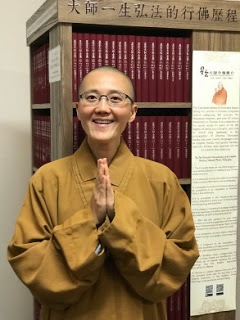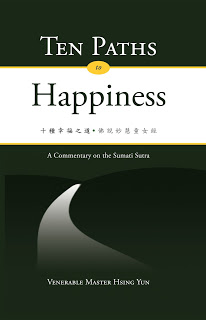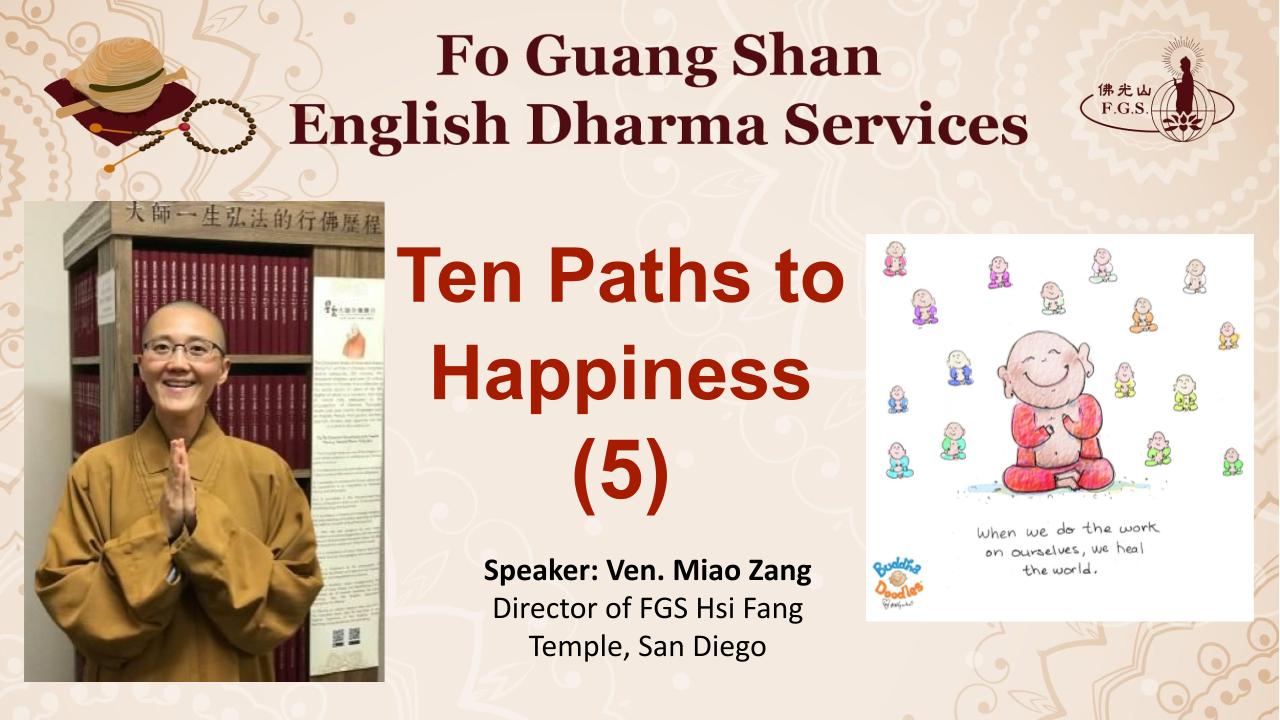
Speaker: Venerable Miaozang
FGS Hsi Fang Temple, San Diego
I. Introduction
Auspicious greetings to all Dharma friends around the world. Thank you for tuning in to a new series of Fo Guang Shan English Dharma Services. I’m Miaozang from Fo Guang Shan Hsi Fang Temple, San Diego, California. How’s everyone’s journey in the pursuit to the path of happiness so far? Hope all is well. If you have any comments or questions, please feel free to leave a message in the comments section.
Today, let us continue our journey together in the pursuit of the 8th and 9th Paths to Happiness.
A quick recap of what we have discussed in the previous session:
- To live blamelessly, we should make good Dharma friends without flattery nor slandering others.
- For us to be trustworthy, we need to be consistent in our words and practice, and do not give rise to unwholesome thoughts in the Dharma we hear.
Now, let us explore the 8th Path to Happiness.
II. The Eight Path to Happiness
The question that Sumati asked, “How can one eliminate obstructions to practice the Dharma?”
The Buddha replied, “Sumati, bodhisattvas have four methods to eliminate Dharma obstructions and be pure. What are the four?
- First, embrace the three categories of bodhisattva precepts.
- Second, after hearing the profound sutras, do not slander them.
- Third, see those who make their initial intention, then give rise to the mind of all wisdom.
- Fourth, treat all sentient beings with great loving-kindness and equanimity.”
Before we discuss the suggested methods, let us understand a little bit more about Dharma obstructions. As defined in the Princeton Dictionary of Buddhism, obstacle or hindrance can be categorized into two, afflicted obstructions and cognitive obstructions.
It states that “Afflicted obstructions are obstructions that arise from the afflictions or defilements whereas cognitive obstructions result from a fundamental misapprehension about the nature of reality. Because of the attachment that derives from the reification of what are imaginary external phenomena, conceptualization and discrimination arise in the mind, which in turn leads to pride, ignorance, and wrong views. Based on the mistakes in understanding generated by these cognitive obstructions, the individual engages in defiled actions motivated by anger, envy, etc., which constitute the afflictive obstructions.”
So, when it comes to afflicted obstructions, we are being obstructed by our afflictions arising from our greed, hatred, unwholesome habitual tendencies, and attachments to our five aggregates, which are form, feelings, perception, mental formations, and consciousness.
As for cognitive obstructions, we are being obstructed by our attachments to our opinions or views, and sometimes we hold to be real and true is exactly what obstructs us from seeing things as they are. In this path, when we practice the Dharma, we should be aware of these obstructions and work to eliminate obstacles and hopefully, attain physical and mental purity.
1) Embrace the Three Categories of Bodhisattva Precepts
As we know the main purpose of upholding precepts is not to harm others. When it comes to bodhisattva precepts, it is an even more proactive way of cultivation, that is to benefit sentient beings. What are the Bodhisattva precepts?
The Bodhisattva precepts comprise of precepts of proper conduct, precepts of wholesome deeds, and precepts of benefiting sentient beings. This is aligned with what the verse of the seven ancient Buddhas “Do nothing that is unwholesome, do all that is wholesome, purify the mind. This is the teaching of all Buddhas.” When we parallel the Bodhisattva precepts with the three vows, they will be as follows:
Precepts of proper conduct → I vow to do no evil
Precepts of wholesome deeds → I vow to do wholesome deeds
Precepts of benefiting sentient beings → I vow to liberate all sentient beings
[Slide 8] In the Teachings Bequeathed by the Buddha Sutra, the Buddha explains: “Precepts are the foundation of liberation.” He uses precepts to tame the unruly minds of us and from there, we learn how to uphold the precepts as a way to discipline ourselves. Most importantly, we understand the intentions behind all precepts. The precepts of not harming others are not just for those who uphold them in a formal Buddhist ceremony but apply to everyone. For example, killing. When a person kills or harms someone, one will be behind bars. However, precepts and regulations are not entirely the same. Precepts come from within by self-discipline whereas regulations are regulated by someone or other outside entity.
This reminds me of my journey in how I become a vegetarian since I was 18 years old. It is not because I have gone through the Bodhisattva precepts ceremony, it is just because of the thought of compassion towards all beings. I remember I came across a story of a little lonely chick in a farm, who could not find its father one day, then its mother the next day, and followed by brothers and sisters… all of them ended up in slaughterhouse. After reading this story, I imagined if I were the little chick, how would I feel? From that day onwards, I started to become a vegetarian. Of course, family and friends are being very considerate and accommodating to my diet. For me, I also tried to give them convenience where I would take the vegetables that had been cooked in the same pot alongside meat. When I was having meals, I always remember to give thanks for everything I had. Nowadays, to be vegetarian is not only a compassionate act towards living beings, we are also being compassionate towards the environment.
The Buddha’s Light International Association (BLIA) has initiated the Vege Plan A to raise the awareness of how having a vegetarian meal can save all livings on earth. When you pledge to have a vegetarian meal a day in a year, you can help to reduce 7 lbs (3kg) of carbon emission, save 426 gallons (1611 litter) of water, reduce 45 lbs (20kg) of food waste and save a tree from being cut down. You can be part of this act by pledging here www.vegdays.org.
The precepts of no killing that I uphold is my vow to be compassionate towards all beings. From this, we always remember that the essence of precepts is to do no evil, do good deeds, and liberate all sentient beings, which are also the three categories of Bodhisattva precepts. Thus, the benefits of upholding the precepts are limitless and boundless. Upholding the precepts is the root of all cultivation. With precepts, we practice to have others in our minds. Then, we will be more aware and mindful of others, which we cultivate meditative concentration. When we are focus, our minds will be clearer, and seeing things as they are, where we develop wisdom. With wisdom, we can avoid going through the repetition of our unwholesome habits as well as in the cycle of birth and death again and again.
2) See Those Who Make Their Initial Intention, Then Give Rise to the Mind of All Wisdom
Initial vow and intention are crucial. It is just like our compass in our practice, continuously aspiring to move forward in the journey in discovering and seeing the Truth of life. It prevents us from regressing, have a goal and motivation. When we first made our initial intention, some of us vow to take refuge in the Triple Gem to be the disciple of the Buddha. Some vow to uphold the precepts of a monastic and be at service to others throughout one’s life. It is easy to set an initial intention, but it might be challenging to uphold it permanently.
I remembered an incident where a devotee who wanted to return her refuge to the Triple Gem. Why would she want to do so? It was because of a senior volunteer who was a little tough on her in making sure all the details of the altar were in place. The venerable asked this devotee, “When you took refuge in the Triple Gem, who did you take refuge in?” She replied with the refuge in the Buddha, Dharma, and Sangha. The venerable then said, “I cannot accept your return in your refuge. Why? It is because you have taken refuge in the Buddha, Dharma, and Sangha, not to the senior volunteer.” After hearing this, the devotee had an “Aha” moment to continue her journey as a practicing Buddhist until today.
Thus, when we make our initial intention, the road ahead might be bumpy. However, the initial intention is the most powerful “energy” that is found within our mind. When we hold strong and have the right understanding of our initial aspiration, we will always remember the original reason and intention of having it in the first place. When we practice the Bodhisattva’s path, no matter what we encountered, we embrace everything with kindness, compassion, joy, and equanimity, giving rise to the mind of all wisdom. Then, the Dharma obstructions along the way will be removed one by one.
III. The Ninth Path To Happiness
Next, on the 9th Path to Happiness,
Sumati asked the questions on how to avoid Mara. It seems to be a follow-up question after learning about Dharma obstructions, what should we do when we encounter the Mara within ourselves?
First of all, what is Mara? Maras are obstacles to cultivation. They originate from within our minds, such as greed, anger, and jealousy, which incite the affliction of ignorance. Maras can be categorized into two, internal maras and external maras. The internal maras are the three poisons, greed, hatred, and ignorance. Also, known as the Mara of Affliction. There is also maras from our physical form, feeling, perception, mental formation or thoughts, and consciousness. Also known as the Mara of Aggregates. As for external maras, it could be anything external that distracts us from our practice. For example, social media, cellphones, or anything pleasant that might divert our focus. So, everything that causes us to regress, damage our dignity, violate the spirit of Buddhism, or deviate from the path can be considered maras.
However, whether it is external or internal maras, everything comes from our defiled mind, a mind with greed, hatred, and ignorance. Take an example when we try to do some research on the website, sometimes we might get distracted by the pop-up advertisements on the side. We might end up browsing other sites that are not related to what we want to research on. Which is the Mara here? The advertisement or our mind that got attracted by what we saw? When we want to review our to-do list on our cellphone, we might receive notifications from the apps on our phone. We could be replying to messages, watching the short video clips and we might lose ourselves in the social media world. Again, which is the Mara?
Now, let us time travel back to 2600 years ago, reviewing the life of the Buddha before enlightenment. According to the text, Mara approached him with images of fear and temptation. However, the Buddha remained unmoved and subjugated the Mara. How did the Buddha do it?
The Buddha shared with Sumati, “Bodhisattvas have four methods for avoiding Mara. What are the four?
- First, completely understand that Dharma nature is equal.
- Second, give rise to diligence.
- Third, constantly contemplate the Buddha.
- Fourth, dedicate the merit from all wholesome roots.”
We will discuss the first two methods, completely understand that Dharma nature is equal, and give rise to diligence.
3) Completely Understand That Dharma Nature is Equal
The Buddha shared the Dharma throughout his whole life after realizing enlightenment, and yet, the Buddha said he did not utter a single word on Dharma. Why did the Buddha say so? The word Dharma, both capitalized “D” (Dharma; teaching of the Budddha) and small letter “d” (dharma; all phenomena) exists around us since beginningless time. Whether the Buddha discovers or not, it is always there. The Buddha uses skillful means and shared with us his discoveries in an understandable way. The Buddha also helped so many beings throughout his whole life and yet he said he had not liberated anyone. Why? It is because all sentient beings are inherently Buddhas who have yet to attain enlightenment. The Buddha does not judge someone’s value by their appearance nor their social status.
In the book titled On Buddhist Democracy, Freedom, and Equality, Venerable Master Hsing Yun commented that, “The Buddha does not position himself above sentient beings; he sees himself as an enlightened sentient being and sentient beings as unenlightened Buddhas. There is no difference between one’s intrinsic nature and the Buddha’s mind.” All beings, including us, exist as part of the dharma in this Dharma realm. The Buddha said, “The Dharma nature is equal.” There is no distinction between each other. If we can completely understand that all Dharma nature is equal, we will not discriminate between the differences as there are no real distinctions. Once our mind can practice equanimity, inequality ceases to exist. When our mind embraces equanimity, not only we will improve, but everything in this world improves. Then, Mara will not be closed to us.
4) Be Diligent
Another common Mara that we encounter is laziness or sloth. One of the best medicine recommended by the Buddha is the right diligence or right effort. In the commentary, the word diligence in Chinese comprises of the two characters of jingjin (精進). The first character is defined as remained pure and undistracted, and the second character is defined as constantly strive without regressing. Together, it has the connotation of moving forward, bravely bearing burdens, being focused, never giving up, and expanding and distilling one’s best qualities. In our practice, it requires continuous diligence for us to remove unwholesome behavior, to cultivate wholesome behavior, to gain happiness, and to liberate ourselves from dukkha.
There was an incident where Aniruddha, one of the great disciples of the Buddha, fell asleep while the Buddha was teaching the Dharma. Buddha reprimanded him, “Those who delight in sleeping are like snails sleeping in their shells. They sleep for a thousand years, never hearing the name of the Buddha.” Aniruddha felt of self-reproach and stopped sleeping since then. Every day, he either engaged in walking meditation or Dharma recitation. Eventually, he lost his eyesight. One day, he wanted to sew his clothes, but he was unable to thread the needle as he could not see. The Buddha knew about this and visited him. The Buddha helped him sew three robes in one day. The Buddha also taught him to practice the Illuminating Vajra Samadhi. Soon after, Aniruddha obtained the power of the divine eye and became the most renowned among the Buddha’s disciples for this ability.
Therefore, we need to practice right diligence to wade away the Mara of extreme. If we are too hasty, we will face setbacks. If we are too lax, laziness will also lead to regression. The Buddha reminded us in the Sutra on the Buddha’s Bequeathed Teachings, “Do not let laziness waste our whole life.” Without diligence, we will be washed away with the current and befriends with the Mara.
IV. Conclusion
To summarize what we have discussed today,
- To remove Dharma obstructions, precepts are the foundation of liberation and we venerate the initial intention and give rise to the mind of all wisdom.
- To avoid the Mara, we should completely understand that Dharma nature is equal and always be diligent in our cultivation.
Next week will be the finale session of the Ten Paths to Happiness. Together, let us practice the Bodhisattva’s path from the Sumati Sutra and let the Buddha within appear!
Let us conclude this lecture by joining our palms, and dedicating the merits of this session to our family, our friends, our society, and all beings. Last but not least, thank you for joining us in today’s session. If you find this lecture series helpful to your practice, please subscribe to the FGS English Dharma Services Youtube Channel and share it with your friends. See you next week. Omituofo.
Ten Paths to Happiness: A Commentary of the Sumati Sutra

By: Venerable Master Hsing Yun
Published by: Buddha’s Light Publications
We all want to be happy. Twenty-six hundred years ago a young girl named Sumati asked the Buddha ten earnest questions on how to live happily in this life and beyond, with the Buddha’s detailed responses revealing that happiness can only be attained when we understand the nature of the world and practice for the benefit of others. In Ten Paths to Happiness, Venerable master Hsing Yun explicates these precious teachings and presents the path to lasting happiness to all who wish for peace, harmony, equality, and liberation from suffering in this life.
Click here for more information.

